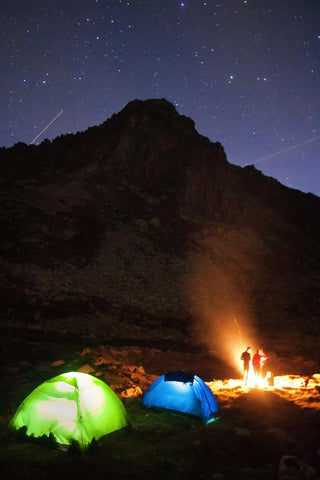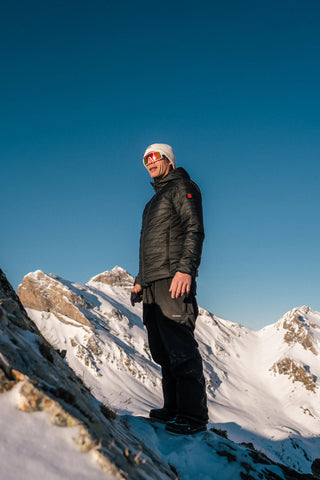
Hiking is a broad term that encompasses many different types of activity. The first is hiking, the most classic... but there are a thousand and one ways to hike! Here's a quick rundown of other winter activities.
1. SNOWSHOEING: HIKING FOR EVERYONE
Snowshoes will be your best companions when hiking on snow. Equipped with forefoot claws for better grip on steep, icy terrain, these snowshoes will facilitate your travels in powder snow.
The advantage of snowshoe trekking is that it's accessible to everyone, and can be adapted to all tastes and abilities, as long as the itinerary is well planned in advance. Many winter sports resorts offer signposted itineraries, giving snow enthusiasts a multitude of possibilities to explore during their winter vacations.
So whether you're an enthusiastic novice or a seasoned adventurer, discover the pleasures of snowshoe trekking!

2. SKI TOURING, THE COMPROMISE BETWEEN WALKING AND GLIDING
Ski touring makes it possible to combine the joy of hiking with the joy of sliding!
Ski touring involves the use of skis similar to those used in alpine skiing, adapted to mountainous terrain with steep slopes and ungroomed snow. During ascent, the heel of the boot remains free to facilitate a gliding movement identical to walking, while on descent it is fixed to control the glide. Synthetic skins are attached to the underside of the skis to aid ascent, and removed for descent. A good level of downhill skiing experience is necessary before embarking on ski touring, as it is very different from cross-country skiing in terms of technique.
For a safe adventure, we recommend that you be accompanied by an experienced guide. Tackling the most technical terrain requires a great deal of know-how, preparation and physical fitness.
The team's little tip: attach your skis to your backpack in hilly areas! With the ski lifts out of the way, you're free to glide along the most remote trails and make your first tracks in the powder.
For novices, many resorts offer safe itineraries along the slopes, facilitating a gentle initiation. Before you set off, ask local residents or tourist offices for information, check weather conditions, and make sure you're properly equipped for this ski touring adventure.
2.1. PREPARATION AND SAFETY
- Training required
- The importance of support
- Safe routes
3. CROSS-COUNTRY SKIING, AN ADVENTURE ON GROOMED TRAILS
Want to glide along while exploring the snow-covered countryside? Cross-country skiing is an activity that can be practised with extra-long, thin skis, ideally on terrain ranging from flat to rolling, and on prepared trails. In this discipline, the heels of the boots remain free to facilitate the pushing movement. In addition, long poles are essential to assist in this propulsion, offering an optimal gliding experience. Cross-country skiing proves to be an excellent training ground for traileurs.

Cross-country skiing offers 3 different styles:
- Classic Cross-Country Skiing: Also known as the alternative style, simply follow the marked trails and let yourself slide while enjoying the panorama. Treat yourself to a peaceful, relaxing experience.
- Skating: For those who love adrenalin, skating is a dynamic and fun option. Glide through snow-covered landscapes in search of thrills and spills.
- Nordic ski touring: have you heard ofnordic cruising? It's an opportunity to get off the beaten track and explore areas untouched by snow. Be prepared to adjust your equipment to suit your choice, and make sure you warm up before you set off.
Don't forget to ask about nearby cross-country ski resorts to make the most of this unique experience.
3.1. DISCIPLINE AND EQUIPMENT
- Cross-country skiing disciplines
- Suit adaptation
- Importance of warm-up
4. BIVOUAC TREKKING, FOR TOTAL IMMERSION
For a memorable adventure, embark on a bivouac trek! Set up your tent under the stars and take on the exciting challenges of the night: mysterious sounds, discreet rain, unexpected visitors. Live the experience to the full, even in winter! For outdoor nights that are as unique as your days, it's important to follow a few basic rules. Be careful, especially if you've never tried a summer bivouac before. Whether there's snow or not, choose your pitch wisely, bring a warm sleeping bag and the right equipment for wilderness camping. In winter, refuges are an alternative, but equip yourself as you would for a night under the stars to face the cold.

4.1. PREPARATION AND EQUIPMENT
- Choice of location
- Equipment required
- Alternative: winter shelter
5. MUSHING
If walking and dogs are your passion, try mushing, also known as dog sledding. You'll be pulled by a dog using a harness and lanyard, offering an experience that's more athletic and more companionable than expected. A cross between a sled dog and a traditional hike, mushing will delight young and old alike, offering new sensations while exploring the pleasures of the mountains in winter.
5.1. SENSATIONS AND EXPERIENCE
- Complicity with the dog
- The alternative between dog sledding and classic hiking
WHY CHOOSE G-HEAT FOR YOUR TOUR?
Technology for comfort. Innovative heating technology from G-Heat offers unrivalled comfort, enabling hikers to enjoy their winter adventures to the full. A range of products for every winter activity. Heated ski gloves, heated socks, heated jackets - whether you're into hiking, skiing or other winter activities, the G-Heat collection offers a variety of heated garments to suit every situation. Explore the special winter sports collection, offering heated garments designed to equip you for the slopes.

WHY CHOOSE G-HEAT FOR YOUR TOUR?
- Unrivalled comfort with innovative heating technology
- Adapt to every winter activity with a wide range of warming garments
- Special winter sports collection for the right equipment on the slopes
---
WINTER HIKING FAQS
1. WHAT'S THE BEST HIKING PRACTICE FOR BEGINNERS?
- For beginners, snowshoeing is often recommended as it is accessible to all fitness levels.
2. DO I NEED PREVIOUS EXPERIENCE TO GO SKI TOURING?
- Yes, it is advisable to have some skiing experience before embarking on ski touring, and to be accompanied by an experienced guide.
3. WHAT EQUIPMENT IS ESSENTIAL FOR A WINTER BIVOUAC?
- Essential equipment includes a sleeping bag and insulating mattress, as well as warm, waterproof clothing.
4. IS IT SAFE TO MUSH WITH ANY DOG?
- No, it's important to choose a dog suited to sledding and to make sure it's well trained and equipped.
5. HOW DO I CHOOSE THE RIGHT HIKING ITINERARY FOR MY LEVEL?
- We recommend that you choose safe, signposted routes suited to your level of fitness and hiking experience. Ask your local tourist office for advice and recommendations.






